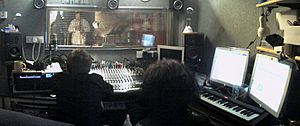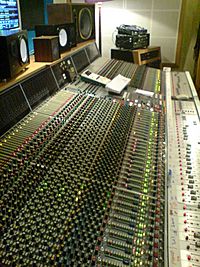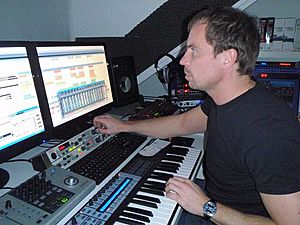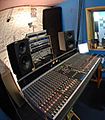Recording studio facts for kids
A recording studio is a special place where people record music, voices, and other sounds. Some studios are independent, meaning they work on their own, while others are part of bigger companies like record labels. Independent studios might record just one band, or they might rent out their space to other artists. Studios can charge by the hour or by the whole project.
Recording studios usually have three main parts:
- A "live area" where groups play music. This area lets sounds echo a little bit naturally.
- A "dead area" which is very quiet and soundproofed. This part is good for recording single singers or instruments without any echoes.
- A "control booth" where all the recording equipment is kept.
Studios are built to be soundproof, so outside noises don't get into the recordings. Special walls and shapes inside the rooms help to keep sounds clear and prevent them from bouncing around too much.
Long ago, recording studios were a lot like radio studios. But over time, they became different. For example, when "multitrack recording" was invented in the 1950s, studios could record many sounds at once on separate tracks. This was something radio stations didn't need as much. Today, some radio stations do use this equipment to record shows ahead of time.
At one point, many studios used lots of digital effects to change sounds. But now, many people prefer to capture the natural sound of the room and use fewer effects.
Contents
How Studios Are Set Up
Main Areas of a Studio
Recording studios usually have a few important rooms:
- The live room is where musicians play their instruments and singers sing. Microphones pick up their sounds. For electric instruments, cables connect them directly to the mixing board, or microphones are placed in front of their speakers.
- Isolation booths or vocal booths are small, soundproof rooms. They are used for loud instruments or for singers. These rooms often have windows so the performers can see other band members and the sound engineers. This helps everyone stay together and follow visual cues.
- The control room is where the sound engineers and producers work. They use a mixing console to combine all the sounds from the microphones and instruments. They record these sounds onto computers or, in the past, onto tape. They listen to the recordings using special speakers or headphones and adjust the sound.
- The machine room holds noisy equipment like power amplifiers. Keeping these machines in a separate room prevents their noise from getting into the recordings.
Studios are designed very carefully to make sure sounds are recorded clearly and accurately. This involves using special materials on the walls to absorb or spread sound. The shape of the rooms also helps control how sound behaves. Studios are also heavily soundproofed from the outside. This stops street noises or other sounds from getting into the microphones. Even though sound isolation is important, windows are often used so everyone can see each other during recording.
What Equipment is Used?
A recording studio has lots of cool gear. Here's some of what you might find:
- A big mixing console: This is like the brain of the studio. It can have many channels, sometimes up to 72, to control different sounds. Smaller mixing consoles might be added if more channels are needed, for example, to record a drum kit.
- Preamplifiers: These boost the small signal from a microphone so it's strong enough to be recorded.
- Multitrack recorders: These machines record many different sounds at the same time on separate tracks. In the past, they used analog tape, but now they mostly use digital hard drives.
- Computers: Powerful computers are used with special software to record, edit, and mix music.
- Lots of different microphones: Studios have many types of microphones to capture different sounds, from quiet vocals to loud instruments.
- DI units: These boxes help connect instruments directly to the mixing board.
- Record players: Sometimes, these are used to play back vinyl records or for DJs.
- Microphone stands: These hold microphones in just the right spot for recording.
- Reference monitors: These are special loudspeakers that play sound very accurately. Engineers use them to hear exactly how the recording sounds.
- Power amplifiers: These make the sound from the mixing console loud enough for the monitor speakers.
- Studio headphones: These are usually closed-shell headphones that keep sound from leaking out and being picked up by microphones.
- Consumer speakers: Engineers also listen to recordings on regular speakers, like car speakers or boom boxes. This helps them hear how the music will sound to everyday listeners at home.
- Digital Audio Workstation (DAW): This is a computer system with software that lets you record, edit, and mix audio.
- Music workstations: These are electronic instruments that can create and arrange music.
- "On Air" or "Recording" signs: These light up to tell people to be quiet during a recording session.
- Effects units: These are special devices that change the sound. They can make sounds louder, add echo, or change the tone. Some common effects include compressors, reverbs, and equalizers.
Instruments in a Studio
Not all studios have musical instruments. Smaller studios might expect bands to bring their own. However, many larger recording studios keep a selection of instruments in their live room. These are often instruments that are big, heavy, or hard to move, like a grand piano or a Hammond organ.
Having instruments in the studio makes it easier for artists. They don't have to bring in lots of heavy gear. It also saves time because the instruments are already set up and ready to go. Studios that own instruments have to maintain them, like tuning pianos.
Instruments you might find in a studio include:
- Keyboard instruments:
- A grand piano
- A Hammond organ with a spinning Leslie speaker
- Electric pianos like Fender Rhodes or Wurlitzer
- MIDI keyboards or stage pianos
- Old-style synthesizers like Moog
- Keyboard amplifiers
- Acoustic drum kit: This usually includes the drums and stands. Drummers often bring their own snare drum and cymbals.
- Bass amplifier and speaker cabinet: For bass guitars.
- Guitar amplifiers and speaker cabinets: For electric guitars.
- Vintage guitars and basses: Older, classic guitars and basses from famous brands.
Sometimes, studios might have unusual instruments like a mellotron or ethnic drums, if bands often want to try different sounds. Guitarists and bassists usually bring their own guitars and effects pedals. Drummers often bring their own snare drum, cymbals, and sticks.
The types of instruments a studio has often depend on the kind of music recorded there. For example, a studio that records heavy metal music might have powerful guitar amps. A studio for country music might have smaller, older-style amps.
In recent years, computers have become super important in recording. With special software like Pro Tools, a powerful computer can do the job of many different pieces of equipment. It can act as the mixing console, multitrack recorder, synthesizer, sampler, and effects unit all in one! A computer set up like this is called a Digital Audio Workstation (DAW). Other popular recording software includes Logic Pro, Cubase, and Ableton Live.
Today, the quality of the audio recording hardware is often more important than the computer itself, unless you're working with MIDI (Musical Instrument Digital Interface). While Apple Macintosh computers are common in studios, there's also great software for Windows and Linux computers. If all the mixing is done on a computer using just a keyboard and mouse, it's called mixing in the box ("ITB"). If other hardware is used alongside the computer, it's called "OTB."
Images for kids
-
The Siemens Studio for Electronic Music around 1956.
-
Donna Summer wearing headphones during a recording session in 1977
-
The studio at Ridge Radio in Caterham, England
See also
 In Spanish: Estudio de grabación para niños
In Spanish: Estudio de grabación para niños











